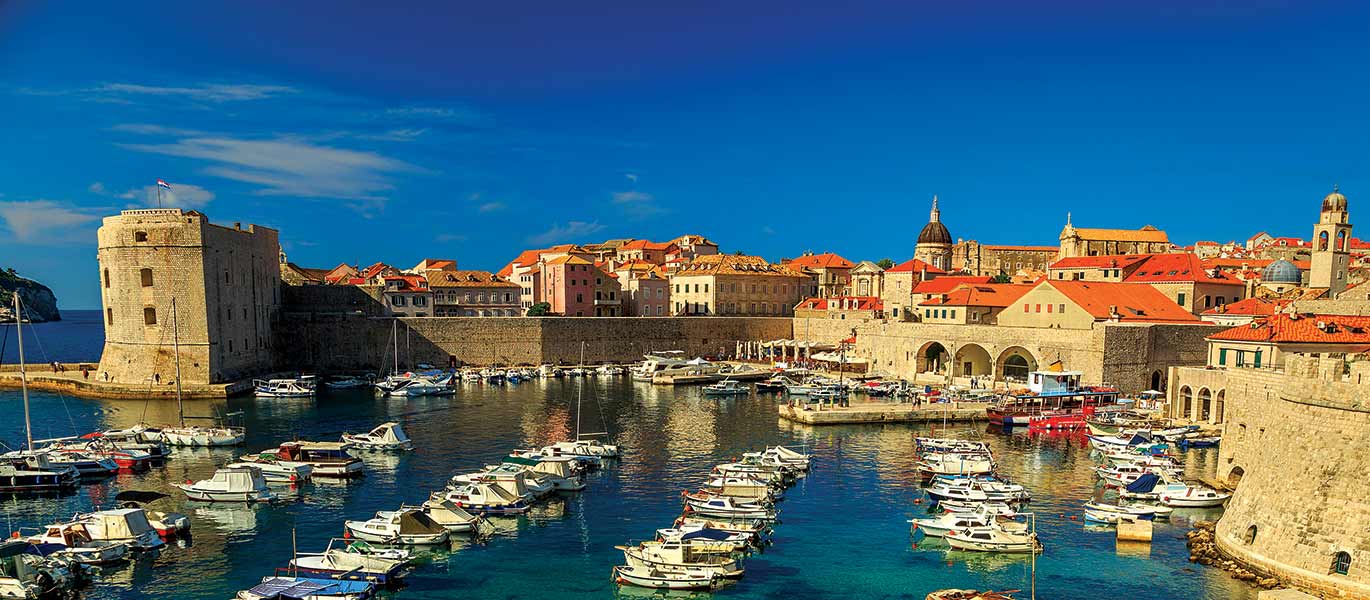Advertisement
If you're looking for one of the best places to charter a boat in the Mediterranean, look to a different sea — in the nearby Adriatic, along Croatia, one of the best and most legendary cruising grounds in the world. Across from Italy, the beautiful, rugged, and mountainous Dalmatian Coast hugs the eastern shore of the Adriatic Sea, and has more than 1,200 miles of meandering coastline, countless peninsulas and protected bays, and hundreds of easily reached islands.
It's among the most magical and easy boating destinations in central Europe, with a justified reputation for friendly locals, excellent restaurants, stunning natural beauty, architecture, and culture, and a very well-supported state-of-the-art charter industry that caters to both power and sail.
We had the memorable experience of sailing through soccer-crazed Croatia during the 2018 World Cup, the first time the national men's team made it to the final (they lost to France in a heart breaker). One night in the tiny fishing village of Bobovišća on the island of Brač, our group joined what seemed to be the entire town for dinner at one of only two waterfront pubs, the locals decked out in red-and-white checkered shirts, the team colors, glued to their beer and a big flat-screen TV.
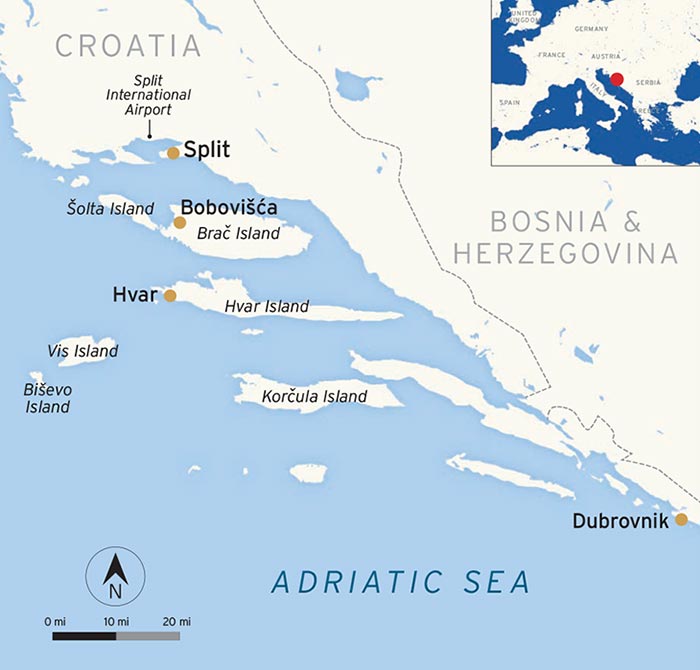
When Croatia finally put Argentina away that evening, the village exploded in elation, as people yelled, sang, hugged, and danced along the ancient stone waterfront to the pulsing red light of handheld marine flares set off by fans. Even the tourists were Croatian that night!
If you were a fan of the show "Game of Thrones," you've already seen some of Croatia's dramatic scenery, as several scenes were filmed there — notably in the ancient walled section of Dubrovnik, a UNESCO World Heritage Site and the main location for the fictional city of King's Landing. A local company recently started cruise ship tours of Croatian coastal sites that appeared in the GoT series, including the picturesque walled harbor city of Split just to the north, where the Roman Emperor Diocletian built his famous palace.
I sailed the area with a private bareboat flotilla with three dozen friends, chartered through the extremely busy and well-run Moorings/Sunsail base Marina Agana, about a half-hour's drive northwest of Split. The marina is easily reached from Split International Airport, which links to several major European airport hubs.
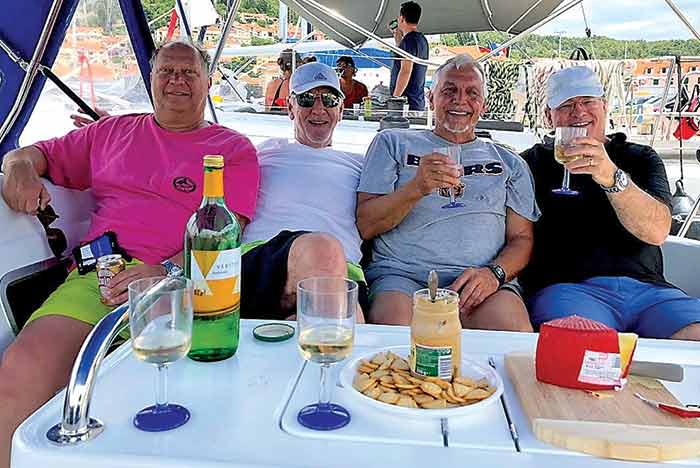
The author bareboat chartered as part of a flotilla with three dozen friends. Here they enjoy appetizers on board. (Photo: Stephen Blakely)
The marina is modern and efficient (it has an engine shop, and every boat comes with its own Wi-Fi) with a friendly and knowledgeable staff who provided an excellent charter briefing and cruising options. The company's inventory is large enough that all but one of our 10 boats were comfortable Jeanneau 47s — providing our fleet the rare opportunity for a fair race heading back to base. (I know it was fair: Our boat won!)
The Cruising Grounds
A strategic crossroads between central and southeast Europe, what is now Croatia has been contested for thousands of years by various feuding empires (Greek, Roman, Venetian, and Ottoman, just for starters), so the region is a rich melting pot of ancient architecture, culture, and history. Today, the formerly communist country is part of the European Union (it still uses its local currency, the Kuna, although the Euro is readily accepted; credit cards, not always). English is commonly spoken among the coastal population, so language is rarely a problem.
The Dalmatian Coast has three zones: northern (which is more remote but offers the picturesque Kornati Islands National Park above Split), central (the most popular, where Split and its closer cruising grounds are located), and southern (which includes Dubrovnik, with one of the world's best-restored medieval walled cites).
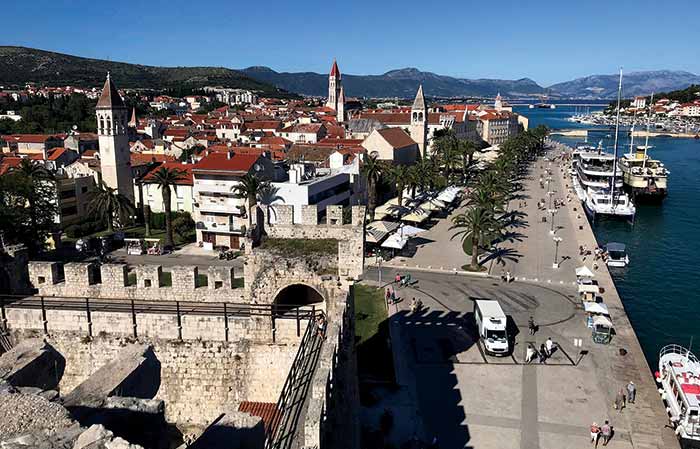
The ancient walled harbor city of Trogir, northwest of Split. (Photo: Stephen Blakely)
Among the most popular island destinations for charter boats are Hvar (Hvar, the island, is popular with families and has lots of affordable unspoiled retreats; the town of Hvar is a spectacular but expensive magnet for hedonists, celebrities, and paparazzi); Rab, the rare Croatian island with lots of sandy beaches (notably Sahara, a famous nude beach); Murter, home of the celebrated Garden Festival and other summertime music events; Šolta, popular with hikers and cyclists; and Silba, a forested paradise for walkers that bans both cars and bikes in summer.
From Marina Agana north of Split, our little fleet sailed as far south as the yacht- and glitterati-filled harbor town of Hvar (crowned by the magnificently restored Fortica, a medieval castle built by the Venetians), and then worked our way back through a circuit that included the interesting islands of Brač, Korčula, and Vis.
Tip
During our weeklong cruise, we found that every town and marina we visited on the Dalmatian Coast was cruiser-friendly and fully capable of supporting charter boats, with skilled dockhands and dependable electric and water. We ate ashore in local pubs and restaurants every night, cooking our breakfasts and lunches on board. Reprovisioning (including fresh fruits and produce) was never a problem.

The fishing village of Milna has ample amenities for cruisers. (Photo: Stephen Blakely)
Just one small example of how deep the history runs here can be found in the charming harbor town of Vis, the farthest inhabited island off the Croatian coast (and one of my favorite stops). It was originally used by the Greek empire in the 4th century B.C. to control shipping in the Adriatic, and later conquered by the Republic of Venice. The British built a garrison overlooking the harbor in the early 1800s — Fort George — to keep Napoleon from turning the Adriatic into a "French lake." (The garrison is now a wonderfully restored bar and restaurant.) During World War II, the island became an air base for British and American warplanes and the headquarters of Marshal Tito's highly effective Yugoslav Partisan resistance against the Nazis. Today, it's a cruising and restaurant hotspot.
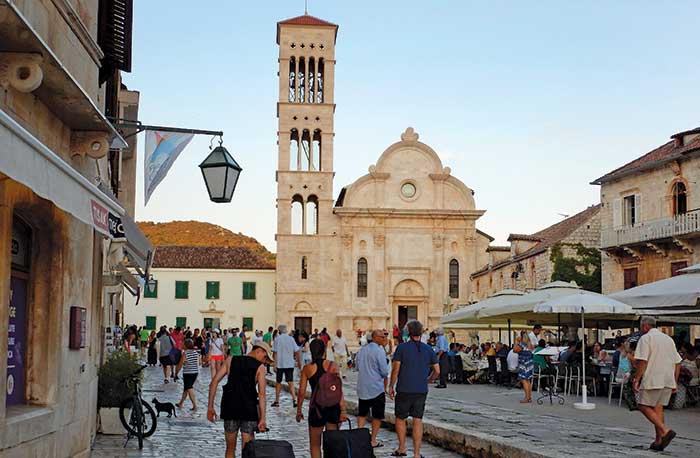
The Baroque-style St. Stephen's Cathedral in Hvar was built in the early 1600s. (Photo: Stephen Blakely)
Weather
In late spring and early summer, the wind and weather tend to be ideal, with one charming and historic harbor town or fishing village after another just a day cruise apart. Winds lighten up in summer and can get strong in the fall. Tides are minimal (around 2 feet), but the Dalmatian Coast has three distinct kinds of strong winds to know about:
- The Bora, a cold and gusty katabatic wind, blowing mainly northeast from the land to sea, typically in the fall.
- The Sirocco, warm and humid, blowing from east-southeast to south-southeast, always accompanied by prolonged rain.
- The Maestral, a pleasant summer sea breeze created by the heated land surface drawing winds off the water, typically in fine weather from morning to afternoon and dying off before sunset. This breeze largely determined the layout of many ancient Dalmatian streets, so it could circulate through town. We caught Maestrals a couple of days, which provided the most spectacular sailing of the trip.
If You Go
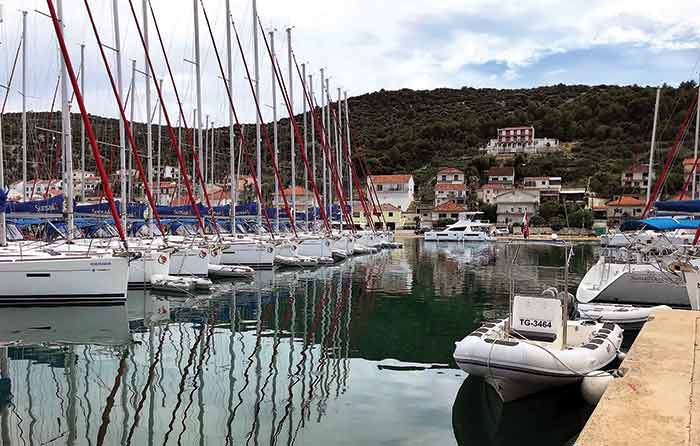
Photo: Stephen Blakely
Here are some handy tips and tricks if you charter in Croatia:
- Med-mooring: For many boaters, the biggest worry about cruising in the Mediterranean and Adriatic is learning how to Med moor: backing the boat perpendicular to a pier or bulkhead, the "end-on" regional custom that jams many boats into a small space. But every marina we visited had professional dockmasters and assistants to help guide you in, and convenient bow lines secured to the bottom — no Med-moor anchoring necessary! The practice quickly became routine. If you arrive too late in the day, be prepared to anchor out: Med-moorings are limited, first-come first-served, and fill up quickly. We had to anchor out only once.
- Avoiding crowds: Croatia's entire Dalmatian Coast is an extremely popular destination in high season, and land-based tourists often find themselves waiting for hours to board the big inter-island ferries. Having our own boats allowed us to avoid all that, but we could not always escape the crowds. Go early or late in the summer if you want to avoid the tourists in Debrovnik and Split in high season.
- Food: Because the Adriatic Sea is fed by many freshwater rivers, its water is less salty than the Mediterranean and produces famously tasty seafood (simply grilled) — and indeed, it was impressive. We also found dockside restaurant prices were very impressive: We quickly learned to go a block or two off the water for more reasonable fare. The favorite local style of cooking food is "under the bell" — a bell-shaped terra cotta pot with a lid, cooked at very high heat inside the embers of an open fire. The country's rocky soil is good for grapes; local wines are often produced by the family running the restaurant and are typically excellent and inexpensive.
- Swimming: Scuba diving is not a big sport in Croatia, although snorkeling is quite popular. (The aptly named Blue Cave on the island of Bisevo is a must-see.) You'll notice there are designated "naturalist" beaches in Croatia (Hey, it's Europe!) and more traditional "family" swimming areas as well. Croatia beaches are often rocky, so bring foot protection.
Chartering
There are dozens of yacht charter firms in Croatia (offering more than 3,700 boats), with well-planned and flexible cruising itineraries to fit your schedule and interests. You'll hear lots of different languages and see flags from all over the world. Most familiar to Americans are The Moorings and Sunsail charters, which are jointly owned but maintain separate business identities and websites.
The Moorings offers bareboat sailing charters but also features power catamarans and fully staffed charters with captain and chef. Sunsail is bareboat-only (both monohulls and catamarans) and offers special flotillas if you want to sail with a group. Sunsail also has a base in Dubrovnik and for an extra fee permits one-way drop-offs — worth it! Two small grocery stores within walking distance of Marina Agana provide most provisions you'll need, but expect competition from other charterers.
Tip
Croatia has proficiency requirements for any skipper chartering a boat. For extended cruising, if not U.S. Coast Guard-licensed, an American skipper must have passed either the US Sailing "Basic Keelboat" course or the ASA "103 Basic Coastal Cruising" or above. Skippers are also required to have a VHF radio operator's license. For those without these qualifications, the charter base offers Day Skipper and Competent Crew courses, which will allow you to charter a boat.
Croatian charter bases typically turn around their boats the day they are brought back (Saturdays, usually), which makes for a late start and short first-day's voyage. Our group's briefing and provisioning started shortly after noon and we cast off around 4 p.m., enough time for a comfortable 19-mile sail to the small town of Milna on Brač Island, arriving shortly before sunset.
Each boat is stocked with the "Adriatic Nautical Guide" for local knowledge. Our group also brought Garmin and Navionics e-charts for the region on our tablets, a valuable supplement to the boat's GPS at the helm.
Having never sailed in Europe before, and not knowing what to expect in Croatia, I found this weeklong cruise to be one of the most enjoyable our little group has taken. The charter boats were among the best-maintained we've experienced, the cruising grounds were spectacular and generally easy (though every trip has its challenges), the culture incredibly deep, vibrant, and fascinating, and the food magnificent; you can dine al fresco everywhere. To paraphrase author Ray Bradbury, if the point of travel is to see the world and stuff your eyes with wonder, this is a place not to be missed.
Resources
If planning travel to Croatia, visit the U.S. Embassy of Croatia website for the latest info as well as entry requirements. As of press time, no COVID testing was required to enter or leave the country. The U.S. Department of State advises to exercise normal precautions when visiting. Passports must be valid for three months after the planned date of departure.

